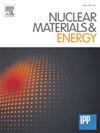硼在钨和钼中的能量学和聚类性质:第一性原理研究的比较分析
IF 2.7
2区 物理与天体物理
Q1 NUCLEAR SCIENCE & TECHNOLOGY
引用次数: 0
摘要
利用第一性原理计算,我们系统地探索了钨(W)和钼(Mo)中杂质B(硼)的几何结构、电子性质、扩散行为和与空位的聚类。在大块金属中,单个B原子更倾向于占据八面体间隙位置(oip)而不是四面体间隙位置(tip)。B原子容易被空位捕获,单个B原子更倾向于占据空位中心附近的oip, W和Mo的捕获能分别为- 2.67和- 2.51 eV。随着捕获过程的进行,一个空位至少可以捕获6B原子,因此该空位被认为是B原子在两种金属中形成BnV簇的捕获中心。对于间隙B和单空位,最有利的扩散路径分别是oip→tip→oip和<;111>;方向。在相同温度下,W中间隙B和单空位的扩散系数比Mo中低约2-9个数量级,说明W中间隙B和单空位的迁移速度都比Mo慢得多。另一方面,由于两种金属中间隙B的扩散系数都明显大于单空位,因此间隙B的迁移要比单空位容易得多。因此,我们得出结论,BnV的形成机制可归因于两种金属中相对稳定的空位捕获了这些相对移动的间隙B原子。本文章由计算机程序翻译,如有差异,请以英文原文为准。
Energetics and clustering properties of boron in tungsten and molybdenum: A comparative analysis from first-principles study
Using first-principles calculations, we have systematically explored the geometric structures, electronic properties, diffusion behavior, and clustering with vacancies for impurity B (boron) in tungsten (W) and molybdenum (Mo). A single B atom prefers to occupy octerhedral interstitial position (oip) rather than tetrahedral interstitial position (tip) in bulk metals. B atoms can be easily captured by vacancies, and a single B atom prefers to occupy an oip next to vacancy center with a capturing energies of −2.67 and −2.51 eV in W and Mo, respectively. As the trapping progresses, at least 6B atoms can be captured by one vacancy, which is therefore regarded as the capturing center of B atoms to form BnV clusters in both metals. For interstitial B and mono-vacancy, the most favorable diffusion pathways are oip → tip → oip and the <111> direction, respectively. At the same temperature, the diffusion coefficients of interstitial B and mono-vacancy in W are about 2–9 orders of magnitude lower than those in Mo, indicating that both interstitial B and mono-vacancy migrate much slower in W than in Mo. On the other hand, since the diffusion coefficient of interstitial B is significantly greater than that of mono-vacancy in both metals, the interstitial B migration is much easier than that of mono-vacancy. We therefore conclude that the BnV formation mechanism can be attributed to that the relatively stable vacancies capture these relatively mobile interstitial B atoms in both metals.
求助全文
通过发布文献求助,成功后即可免费获取论文全文。
去求助
来源期刊

Nuclear Materials and Energy
Materials Science-Materials Science (miscellaneous)
CiteScore
3.70
自引率
15.40%
发文量
175
审稿时长
20 weeks
期刊介绍:
The open-access journal Nuclear Materials and Energy is devoted to the growing field of research for material application in the production of nuclear energy. Nuclear Materials and Energy publishes original research articles of up to 6 pages in length.
 求助内容:
求助内容: 应助结果提醒方式:
应助结果提醒方式:


